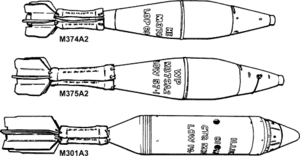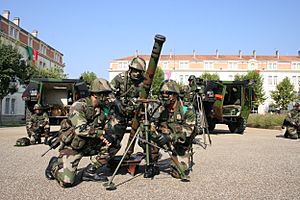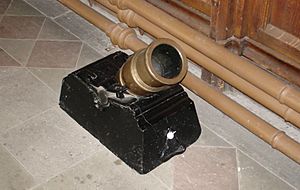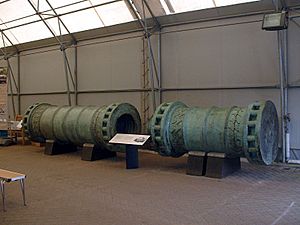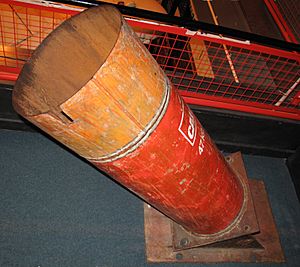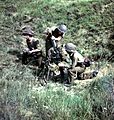Mortar (weapon) facts for kids
A mortar is a type of artillery weapon. It shoots special explosive shells, which are often called mortar bombs. Mortars are used to hit targets that are not too far away. They have a short barrel that launches the bomb high into the air. The bomb then drops down onto its target. Mortars have been used since medieval times.
They come in many sizes. Some mortars are very large and heavy. Others are small enough for one soldier to carry. Mortars are called "indirect fire" weapons. This means the bomb falls onto the target from above. Soldiers using a mortar do not need to see their target directly.
Contents
How Mortars Are Used
Mortars are quite simple to use. Modern mortars have a tube where a soldier drops a bomb. The tube is usually set at an angle between 45 and 90 degrees from the ground. A higher angle means the bomb will travel a shorter distance.
When the bomb reaches the bottom of the tube, it hits a special part called a firing pin. The weight of the mortar bomb is usually enough to set off the firing pin. This makes the bomb fire out of the tube. Some bigger mortars use a string to set off the firing pin instead of it happening automatically.
From the 1700s to the early 1900s, very heavy mortars were used to attack fortified places. These were hard to move. Some had barrels up to one meter wide. They were often made of heavy cast iron. Smaller, easier-to-move designs became popular during the First World War. Mortars are still used by armies today.

Light and medium mortars are easy to move around. Infantry (foot soldiers) often use them. Mortars can fire from a trench or from behind cover. This helps keep the soldiers safe.
Heavy mortars usually have barrels between 120 and 300 millimeters wide. These large weapons are often pulled by vehicles or placed on top of them. Sometimes, they are loaded from the back of the barrel. They are used by larger army groups like battalions or divisions. Even these big mortars are simpler and cheaper than other large guns like howitzers.
One or more people can move a mortar. Bigger mortars can be taken apart into smaller pieces. Some mortars are carried in special vehicles called mortar-carriers. These are often changed armored vehicles or ones built just for mortars. They have a large opening on the roof for firing. Some new heavy mortars, like the AMOS PT1, have two barrels. They are put on armored vehicles or patrol boats.
Lighter mortars are usually used by at least two soldiers. Heavier mortars need three to five soldiers to operate them. Small mortars can be fired from almost any good spot. Medium mortars are often fired from strong, prepared positions.
Mortar Design
Most modern mortars have three main parts. These are the barrel, a plate for the barrel to stand on (called a base plate), and a bipod (a two-legged stand).
Mortars are usually medium-sized weapons. However, there are both smaller and larger ones. For example, the British 51 mm Light Mortar is small enough for one soldier to carry. It only has a tube and a base plate. A very large example is the Soviet 2S4 M1975 Tyulpan (which means "tulip") mortar. This huge mortar is 240 mm wide and moves on its own.
Mortars can be unstable on soft ground or snow. This is because the force of firing (called recoil) pushes them down. A special bag called a Raschen Bag can help prevent this problem.
Mortar Ammunition
The things that mortars fire are correctly called "bombs." They are shaped like bombs dropped from aircraft. They also have fins that help them fly straight.
Mortars can fire many different types of bombs:
- High explosive bombs: These are normal bombs that explode when they hit the ground.
- White phosphorus bombs: These create a thick smoke screen. This smoke can blind the enemy. It also hides friendly troops when they move.
- Illumination bombs: These are like flares. They hang under a parachute and light up the battlefield at night.
Special Features of Mortars
Mortars are usually smaller and lighter than other big guns like howitzers. When a mortar bomb is fired, it goes very high. Then it comes down at a very steep angle, almost straight down.
Mortars are very useful when they are hidden. They are even more helpful when there are people on the battlefield who can tell the mortar where to fire. These people are called forward observers.
History of Mortars
Mortars have been around for hundreds of years. They were first used to attack castles and cities during sieges. In 1456, during the Siege of Belgrade (1456), the Ottoman Turks used seven mortars. These mortars fired stone shots very high into the air. People said the shots moved very slowly. Observers could warn soldiers to get out of the way.
Early mortars, like the Pumhart von Steyr, were huge and hard to move. An early mortar that could be moved more easily was invented by Baron Menno van Coehoorn in 1673. During the Siege of Vicksburg in the American Civil War, General Ulysses S. Grant even made mortars from logs. He bored out logs to fit shells and wrapped them with iron bands.
Mortars were very important in the muddy trenches of the First World War. Because mortar bombs fell at a steep angle, they could land right inside an enemy trench.
During the Battle of Iwo Jima in World War II, the Japanese army used very large 320 mm mortars against American forces.
Biggest Mortars Ever Made
The largest mortars ever built were huge!
- The French "Monster Mortar" (975 mm wide) was made in 1832.
- Mallet's Mortar (910 mm wide) was tested in London in 1857.
- The "Little David" (914.4 mm wide) was made in the United States for World War II.
All three of these mortars were about 36 inches wide. However, only the "Monster Mortar" was actually used in battle, at the Battle of Antwerp in 1832.
"Home-made" Mortars
Sometimes, groups that are fighting against an army or government have used "home-made" mortars. These are often used to attack military bases or to scare people. An early example was the Davidka, used in 1948 during the Israeli War of Independence.
Well-known examples were used by the Provisional Irish Republican Army (IRA) in the 1970s, 80s, and 90s. The biggest ones were called "barracks busters." They were usually made from heavy steel pipes on a steel frame.
One famous event was the 1985 Newry mortar attack, where nine police officers were killed. Another was the Downing Street mortar attack in 1991. In this attack, the IRA fired mortars at 10 Downing Street, the home of the British Prime Minister. Three bombs were fired, but only one exploded. It landed in the Prime Minister's back garden. It only broke windows. The Prime Minister, John Major, had to move to another house while repairs were made.
Gallery
-
120 mm High Explosive mortar bomb.
-
A 120 mm High Explosive mortar bomb.
-
An 81mm white phosphorus mortar shell.
-
Wiesel 2 lePzMrs (Lightweight Armoured Mortar of Advanced Mortar System) of the German Army.
-
A Canadian mortar team fighting in France, 1944.
Related Pages
Images for kids
-
Engraving depicting the Venetian siege of the Acropolis of Athens, September 1687. The path of the shell that hit the Parthenon, causing its explosion, is marked.
See also
 In Spanish: Mortero (arma) para niños
In Spanish: Mortero (arma) para niños



